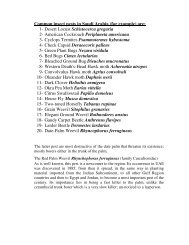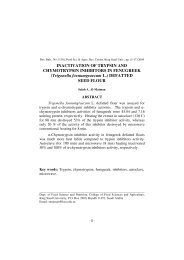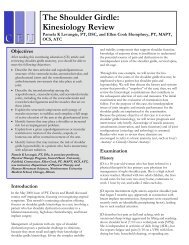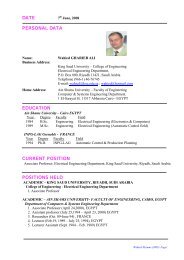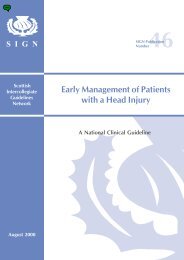Distribution of Sandflies (Diptera: Psychodidae) in Saudi Arabia
Distribution of Sandflies (Diptera: Psychodidae) in Saudi Arabia
Distribution of Sandflies (Diptera: Psychodidae) in Saudi Arabia
You also want an ePaper? Increase the reach of your titles
YUMPU automatically turns print PDFs into web optimized ePapers that Google loves.
Res. Bult., No. (171), Food Sci. & Agric. Res. Center, K<strong>in</strong>g Saud Univ., pp. (5-23) 2010<br />
<strong>Distribution</strong> <strong>of</strong> <strong>Sandflies</strong> (<strong>Diptera</strong>: <strong>Psychodidae</strong>)<br />
<strong>in</strong> <strong>Saudi</strong> <strong>Arabia</strong><br />
Alahmed, A. M. , Kheir, S.M. and Al Khereji, M.A.<br />
ABSTRACT: A survey for sandflies (<strong>Diptera</strong>: <strong>Psychodidae</strong>) <strong>in</strong> <strong>Saudi</strong><br />
<strong>Arabia</strong> was conducted dur<strong>in</strong>g the period March 2004 to February 2006, and<br />
6530 sandfly specimens which represented 2 genera and 22 species were<br />
collected us<strong>in</strong>g light traps. Among these, n<strong>in</strong>e species belonged to the genus<br />
Phlebotomus which constituted 65.5% (4212 sandflies), and 13 species<br />
belonged to the genus Sergentomyia which constituted 34.5% (2318<br />
sandflies) were encountered. The collected sandflies <strong>in</strong>cluded Phlebotomus<br />
alexandri S<strong>in</strong>ton, P. arabicus Theodor, P. bergeroti Parrot, P. kazeruni<br />
Theodor & Mesghali, P. major Adler & Theodor, P. orientalis Parrot, P.<br />
papatasi (Scopoli), P. saevus Parrot & Mart<strong>in</strong>, P. sergenti Parrot,<br />
Sergentomyia adleri (Theodor), S. africana (Newstead), S. antennata<br />
(Newstead), S. calcarata (Parrot), S. christophersi (S<strong>in</strong>ton), S. clydei<br />
(S<strong>in</strong>ton), S. dreyfussi Parrot, S. fallax (Parrot), S. magna(S<strong>in</strong>ton), S. schwetzi<br />
(Adler, Theodor & Parrot), S. sonyae Lewis, S. squamipleuris (Newstead)<br />
and S. tiberiadis (Adler, Theodor & Lourie). The new distribution and<br />
relative abundance <strong>of</strong> these sandflies <strong>in</strong> each collection site <strong>in</strong> <strong>Saudi</strong> <strong>Arabia</strong><br />
is discussed.<br />
Key words: <strong>Distribution</strong>, <strong>Psychodidae</strong>, <strong>Sandflies</strong>, <strong>Saudi</strong> <strong>Arabia</strong>.<br />
________________________________________________________<br />
Plant Protection Department, College <strong>of</strong> Food and Agricultural Sciences, K<strong>in</strong>g Saud<br />
University, P. O. Box 2460, Riyadh 11451, <strong>Saudi</strong> <strong>Arabia</strong>.<br />
- 5 -
INTRODUCTION<br />
Phlebotom<strong>in</strong>e sandflies (<strong>Diptera</strong>: <strong>Psychodidae</strong>) are widespread<br />
<strong>in</strong> the tropics and subtropics, and they transmit Leishmania, protozoan<br />
parasites which cause visceral leishmaniasis (VL) and various forms<br />
<strong>of</strong> cutaneous leishmaniasis (CL) which <strong>in</strong>fect more than 350 million<br />
people <strong>in</strong> more than 80 countries (Lane, 1993). <strong>Sandflies</strong> also transmit<br />
a bacterium which causes bartonellosis <strong>in</strong> northwestern South<br />
America, and sandfly fever virus throughout North Africa and the<br />
Middle East (Lane, 1993).<br />
Dur<strong>in</strong>g the past few decades, <strong>Saudi</strong> <strong>Arabia</strong> has witnessed<br />
tremendous efforts <strong>in</strong> social development and urbanization <strong>in</strong> all<br />
prov<strong>in</strong>ces, which have affected <strong>in</strong>sect fauna, particularly sandflies.<br />
Expansion <strong>of</strong> agricultural projects, urbanization and development <strong>of</strong><br />
water resources, have lead to creation <strong>of</strong> new breed<strong>in</strong>g sites for<br />
sandflies.<br />
Although several reports are available on the distribution <strong>of</strong><br />
sandflies <strong>in</strong> <strong>Saudi</strong> <strong>Arabia</strong> (Lewis and Buttiker, 1980, 1982; Buttiker<br />
and Lewis, 1983; Killick-Kendrick et al., 1985; Tosson and<br />
Alseghayer, 1992; Aldawood et al., 2004; Abdelwahab and Abdoon,<br />
2005; Al Barrak, 2005 and Al Badry et al., 2009), more recent<br />
<strong>in</strong>formation on the distribution and abundance <strong>of</strong> sandflies <strong>in</strong> <strong>Saudi</strong><br />
<strong>Arabia</strong> is required before embark<strong>in</strong>g on large scale control projects.<br />
Studies <strong>of</strong> the distribution <strong>of</strong> Phlebotom<strong>in</strong>e sandflies are important for<br />
evaluat<strong>in</strong>g the possible effects <strong>of</strong> climate change on any range shift <strong>of</strong><br />
leishmaniasis or other diseases they transmit.<br />
Study area:<br />
MATERIALS AND METHODS<br />
<strong>Saudi</strong> <strong>Arabia</strong> is a vast country with an area <strong>of</strong> about 2.25<br />
million km². It lies <strong>in</strong> the southwestern part <strong>of</strong> Asia between lat. 15º<br />
44' N - 32º 9' N, and long. 34º 24' E - 55º 39' E (Fig. 1). The K<strong>in</strong>gdom<br />
is an extremely arid area, except for the southwestern region and some<br />
- 6 -
Fig. 1: Map <strong>of</strong> <strong>Saudi</strong> <strong>Arabia</strong> show<strong>in</strong>g collection sites <strong>of</strong> sand flies.<br />
- 7 -
coastal zones. The topography <strong>of</strong> the k<strong>in</strong>gdom is characterized by the<br />
mounta<strong>in</strong>s <strong>in</strong> the south and the west, plateaus <strong>in</strong> the north and the<br />
center, sand dunes and desert <strong>in</strong> the east and some scattered valleys<br />
(Brown, 1968 and Mohammede<strong>in</strong>, 2001).<br />
The southwestern part <strong>of</strong> the K<strong>in</strong>gdom is a mounta<strong>in</strong>ous area<br />
and is divided <strong>in</strong>to 3 dist<strong>in</strong>ct topographical zones depend<strong>in</strong>g on the<br />
geographical characteristics: Sarawat Asir (which is mounta<strong>in</strong> series<br />
extend<strong>in</strong>g north-south along the coastal pla<strong>in</strong>s <strong>of</strong> the Red Sea), Asir<br />
Plateau and Tihama lowlands. The Eastern Region <strong>of</strong> <strong>Saudi</strong> <strong>Arabia</strong> is<br />
a desert region which <strong>in</strong>cludes the part <strong>of</strong> the K<strong>in</strong>gdom located along<br />
the <strong>Arabia</strong>n Gulf between the Sultanate <strong>of</strong> Oman to the south and<br />
Kuwait to the north. The region is separated from the <strong>in</strong>terior by the<br />
sand dunes known as Al Dahna, and is bordered to the south by “Al<br />
Rub Al Khali” (the Empty Quarter desert).<br />
The western coastal escarpment can be considered two<br />
mounta<strong>in</strong> ranges separated by a gap at the vic<strong>in</strong>ity <strong>of</strong> Makka Al<br />
Mukarrama. The northern range seldom exceeds 2100 meters above<br />
sea level, and the elevation gradually decreases towards the south to<br />
about 600 meters around Makka Al Mukarrama, with some coastal<br />
pla<strong>in</strong>s. The climate is hot dry <strong>in</strong> summer and warm, slightly humid <strong>in</strong><br />
w<strong>in</strong>ter.<br />
Al Qassim Region is located at the heart <strong>of</strong> the K<strong>in</strong>gdom, and<br />
has a typical desert climate, which is cold ra<strong>in</strong>y <strong>in</strong> w<strong>in</strong>ter and hot dry<br />
or with low humidity <strong>in</strong> summer. It is divided by Wadi Al Rumma<br />
(Rumma Valley), which is the longest valley <strong>in</strong> <strong>Arabia</strong>n Pen<strong>in</strong>sula,<br />
from the west to northeast. The region lies at an altitude <strong>of</strong> 600-750<br />
meters above sea level and it is glid<strong>in</strong>g from west to east <strong>in</strong> general.<br />
Agriculture is the cornerstone <strong>of</strong> the region’s economy, and it<br />
produces corn, dates, citrus and some vegetables.<br />
Al Mad<strong>in</strong>ah Al Munawwarah Region is an upland plateau<br />
scored by numerous valleys (wadis) covered with grasses and scrub<br />
vegetations which are used for pasture. It has a typical desert climate,<br />
which is cold ra<strong>in</strong>y <strong>in</strong> w<strong>in</strong>ter and hot dry <strong>in</strong> summer. Al Mad<strong>in</strong>ah Al<br />
Munawwarah is one <strong>of</strong> the biggest oases <strong>in</strong> the region and famous for<br />
grow<strong>in</strong>g dates. The topography <strong>of</strong> the Northern Region is<br />
- 8 -
characterized by the presence <strong>of</strong> high plateaus which are extension <strong>of</strong><br />
"Badiat Al Sham". The vegetative cover <strong>of</strong> the study area is very<br />
poor, except for some coastal zones. The climate and vegetation <strong>of</strong><br />
<strong>Saudi</strong> <strong>Arabia</strong> were studied by several authors (Khattab and El<br />
Haddidy, 1971; Mandaville, 1973 and Abulfatih and El Khalili, 1978).<br />
Collection and identification <strong>of</strong> sandflies:<br />
<strong>Sandflies</strong> collection was conducted dur<strong>in</strong>g the period March<br />
2004 to February 2006 dur<strong>in</strong>g a country-wide survey for mosquitoes.<br />
For collection, 18 collection sites represent<strong>in</strong>g different ecological<br />
zones <strong>in</strong> the K<strong>in</strong>gdom were selected (Fig. 1). In each collection site,<br />
adult sandflies were collected us<strong>in</strong>g one Center for Disease Control<br />
m<strong>in</strong>iature light trap (CDC) and one standard New Jersey (NJ) light<br />
trap (Bioquip Company, Gardena, CA, 90248-3602, USA). The CDC<br />
and the NJ light traps were attached to a battery that supplies power,<br />
and <strong>in</strong>stalled permanently near suitable sandfly breed<strong>in</strong>g sites such as<br />
near rodents’ burrows, human habitation or animal hous<strong>in</strong>gs. The light<br />
traps were operated once every two weeks from sunset at 18:00 hrs to<br />
sunrise at 06:00 hrs the follow<strong>in</strong>g day throughout the study period.<br />
The collected adult sandflies were preserved <strong>in</strong>to 80% ethyl alcohol <strong>in</strong><br />
glass vials with screw caps, labeled and sent to the Entomology<br />
Laboratory, College <strong>of</strong> Food and Agricultural Sciences, K<strong>in</strong>g Saud<br />
University, Riyadh. Adult sandflies were identified by Dr. El Hossary,<br />
S. S., an expert <strong>in</strong> sandflies taxonomy, from Naval American Medical<br />
Research Unit 3 (NAMRU 3), Cairo, Egypt and Pr<strong>of</strong>. Mahmoud<br />
Wahba, Department <strong>of</strong> Medical Entomology, Suez Canal University,<br />
Egypt.<br />
RESULTS AND DISCUSSION<br />
Dur<strong>in</strong>g this study 6530 sandflies, which represented 2 genera<br />
and 22 species, were collected. Out <strong>of</strong> these, 4212 (64.5%) were<br />
Phlebotomus sandflies which belong to 9 species (Table 1), and 2318<br />
(35.5%) were Sergentomyia sandflies which belong to 13 species<br />
(Table 2). The sandflies collected <strong>in</strong>cluded Phlebotomus alexandri<br />
- 9 -
- 10 -
- 11 -
S<strong>in</strong>ton, P. arabicus Theodor, P. bergeroti Parrot, P. kazeruni Theodor<br />
& Mesghali, P. major Adler & Theodor, P. orientalis Parrot, P.<br />
papatasi (Scopoli), P. saevus Parrot & Mart<strong>in</strong>, P. sergenti Parrot,<br />
Sergentomyia adleri (Theodor), S. africana (Newstead), S. antennata<br />
(Newstead), S. calcarata (Parrot), S. christophersi (S<strong>in</strong>ton), S. clydei<br />
(S<strong>in</strong>ton), S. dreyfussi Parrot, S. fallax (Parrot), S. magna (S<strong>in</strong>ton), S.<br />
schwetzi (Adler, Theodor& Parrot), S. sonyae Lewis, S. squamipleuris<br />
(Newstead) and S. tiberiadis (Adler, Theodor & Lourie).<br />
The total numbers <strong>of</strong> Phlebotomus and Sergentomyia sandflies<br />
collected <strong>in</strong> each collection site are shown <strong>in</strong> Table (3). The results<br />
showed that sandflies were widely spread <strong>in</strong> <strong>Saudi</strong> <strong>Arabia</strong>, and the<br />
highest numbers were collected from Abha, Jazan and Najran Regions<br />
<strong>in</strong> the southwestern part <strong>of</strong> <strong>Saudi</strong> <strong>Arabia</strong>, while the lowest numbers<br />
were collected from Al Jouf and Tabouk Regions where only<br />
Phlebotom<strong>in</strong>e sand flies were collected. The overall relative<br />
abundance <strong>of</strong> Phlebotomus (Table 4) and Sergentomyia (Table 5)<br />
sandflies showed that Phlebotomus papatasi is the most widespread<br />
species (24.65%), while P. major is the least spread species (0.14%).<br />
Phlebotom<strong>in</strong>e sandflies <strong>in</strong> <strong>Saudi</strong> <strong>Arabia</strong>:<br />
Phlebotomus alexandri S<strong>in</strong>ton:<br />
Only 101 specimens were collected from Al Taif, Abha, Jazan,<br />
Najran, Al Riyadh, Al Dawadmi and Al Qassim (Table 1). This<br />
species was reported earlier from Riyadh and Al Mad<strong>in</strong>ah Al<br />
Munawwarah Regions (Lewis and Buttiker, 1982) and from Asir<br />
(Abdelwahab and Abdoon, 2005). It is the ma<strong>in</strong> vector <strong>of</strong> L. donovani<br />
from North Africa to western Ch<strong>in</strong>a (Lane, 1993). It was suspected to<br />
be the ma<strong>in</strong> vector <strong>of</strong> visceral leishmaniasis <strong>in</strong> the southwestern part<br />
<strong>of</strong> <strong>Saudi</strong> <strong>Arabia</strong> (Al Zahrani et al., 1997).<br />
P. arabicus Theodor:<br />
Dur<strong>in</strong>g this study, 259 specimens were collected from Makka<br />
Al Mukarrama, Al Bahah, Abha, Jazan, Najran and Al Dawadmi. It<br />
was reported from Asir (Lewis and Buttiker, 1982 and Abdelwahab<br />
and Abdoon, 2005) and Al Bahah (Lewis and Buttiker, 1980).<br />
- 12 -
Table (3): Total numbers <strong>of</strong> sandflies collected from different sites <strong>in</strong><br />
<strong>Saudi</strong> <strong>Arabia</strong><br />
collection site<br />
Total<br />
Phlebotomus<br />
spp.<br />
- 13 -<br />
Total<br />
Sergentomyia<br />
spp.<br />
Total<br />
sandflies<br />
AL Hassa 234 (60.78%) 151(39.22%) 385<br />
Al Dammam 142 (57.72%) 104(42.28%) 246<br />
Hafr Al Bat<strong>in</strong> 35 (39.78%) 53 (60.22%) 88<br />
Hail 145 (87.87%) 20(12.13%) 165<br />
Al Jouf 37(100%) 0 (0%) 37<br />
Tabouk 80 (100%) 0 (0%) 80<br />
Al Mad<strong>in</strong>ah Al<br />
Munawwara<br />
Makka Al<br />
Mukarrama<br />
307(62.4%) 185(37.6%) 492<br />
101(37.27%) 170(62.73%) 271<br />
Jeddaha 67 (38.5%) 107 (61.5%) 174<br />
Al Taif 114 (52.54%) 103 (47.46%) 217<br />
Al Baha 314 (79.69%) 80 (20.31%) 394<br />
Abha 547 (49.5%) 558 (50.5%) 1105<br />
Jazan 629 (69.97%) 270(30.03%) 899<br />
Najran 586 (68.22%) 273 (31.78%) 859<br />
Wadi Al Dawasir 71 (71.71%) 28(28.29%) 99<br />
Al Riyadh 373 (81.45%) 85 (18.55%) 458<br />
Al Dawadmi 164 (78.09%) 46(21.91%) 210<br />
Al Qassim 266 (75.78%) 85 ( 24.22%) 351<br />
Total number<br />
collected<br />
4212 2318 6530<br />
Total % 64.50% 35.50% 100%
- 14 -
- 15 -
P. bergeroti Parrot:<br />
In this study, 1212 specimens were collected from almost all<br />
collection sites except the Eastern and the Northern Regions. It was<br />
reported earlier from Asir (Lewis and Buttiker, 1982 and Abdelwahab<br />
and Abdoon, 2005), Al Bahah, Jazan, Makka Al Mukarrama, Al<br />
Mad<strong>in</strong>ah Al Munawwarah, Najran and Riyadh (Lewis and Buttiker,<br />
1982; Tosson and Alseghayer, 1992; Al Badry et al., 2009 and<br />
Aldawood et al., 2004). P. bergeroti may play a major role <strong>in</strong><br />
transmission <strong>of</strong> leishmaniasis <strong>in</strong> Asir Region (Abdelwahab and<br />
Abdoon, 2005).<br />
P. kazeruni Theodor & Mesghali:<br />
Only 87 specimens were reported from Hail, Tabouk, Al Taif,<br />
Najran, Al Dawadmi and Al Qassim. It was reported from Al Taif by<br />
Nadim et al. (1979). Further studies on the medical importance <strong>of</strong> this<br />
species are required.<br />
P. major Adler & Theodor:<br />
Only 9 specimens were collected from Hail. The medical<br />
importance <strong>of</strong> this species requires further <strong>in</strong>vestigation.<br />
P. orientalis Parrot:<br />
Dur<strong>in</strong>g this study 170 specimens were collected from Al<br />
Mad<strong>in</strong>ah Al Munawwarah, Al Taif, Al Bahah, Abha, Jazan and<br />
Najran. It was suspected to be the ma<strong>in</strong> vector <strong>of</strong> visceral<br />
leishmaniasis <strong>in</strong> the southwestern part <strong>of</strong> <strong>Saudi</strong> <strong>Arabia</strong> (Al Zahrani et<br />
al., 1997).<br />
P. papatasi (Scopoli):<br />
This is the most widespread anthropophagic species <strong>in</strong> <strong>Saudi</strong><br />
<strong>Arabia</strong>, where 1610 specimens were collected from all collection sites.<br />
It is the ma<strong>in</strong> vector <strong>of</strong> CL <strong>in</strong> many part <strong>of</strong> <strong>Saudi</strong> <strong>Arabia</strong> (Killick-<br />
Kendrick et al., 1985), and may be the major vector <strong>of</strong> CL <strong>in</strong> Al<br />
Qassim Region (Lewis and Buttiker, 1980, Al Barrak, 2005). It was<br />
reported from Asir (Lewis and Buttiker, 1980, Abdelwahab and<br />
Abdoon 2005), Al Qassim (Al Barrak, 2005), Riyadh (Lewis and<br />
Buttiker, 1980, Aldawood et al., 2004, Tosson and Alsegyhayer,<br />
- 16 -
1992), Al Mad<strong>in</strong>ah Al Munawwarah (Lewis and Buttiker, 1980 and<br />
AL Badry et al., 2009), Hail (Bakr, 1995), southern part <strong>of</strong> <strong>Saudi</strong><br />
<strong>Arabia</strong> (Al Zahrani et al., 1997), Al Hassa (Killick-Kendrick et al.,<br />
1985) and Najran (Lewis and Buttiker, 1980).<br />
P. saevus:<br />
Only 17 specimens were collected from Jeddaha, Al Taif and<br />
Jazan. It is an uncommon species because it occurs near the<br />
Palaearctic–Afrotropical borders, but does not extend far <strong>in</strong>to either<br />
regions (Lewis and Buttiker, 1982). It was reported earlier from<br />
Riyadh and Asir (Lewis and Buttiker, 1982).<br />
P. sergenti Parrot:<br />
Dur<strong>in</strong>g the study, 747 specimens were collected from allover<br />
the K<strong>in</strong>gdom, except Wadi Al Dawasir and the Eastern Region.<br />
Phlebotomus sergenti was reported earlier from Al Mad<strong>in</strong>ah Al<br />
Munawwarah (Al Badry et al., 2009) and Riyadh (Aldawood et al.,<br />
2004). It was a proven vector <strong>of</strong> L. tropica <strong>in</strong> the southern region <strong>of</strong><br />
<strong>Saudi</strong> <strong>Arabia</strong> (Al Zahrani et al., 1988).<br />
Sergentomyia sandflies <strong>in</strong> <strong>Saudi</strong> <strong>Arabia</strong>:<br />
Sergentomyia adleri (Theodor):<br />
Only 42 specimens were collected from Al Bahah, Abha,<br />
Jazan, Najran, Wadi Al Dawasir and Al Qassim. This species was also<br />
reported from Asir, Al Qassim, Jazan and Makka Al Mukarrama<br />
(Lewis and Buttiker, 1982).<br />
S. africana (Newstead):<br />
Only 37 specimens were collected from Jazan, Najran and<br />
Abha. The distribution <strong>of</strong> this species is not well known <strong>in</strong> <strong>Saudi</strong><br />
<strong>Arabia</strong>.<br />
S. antennata (Newstead):<br />
This is the most widespread Sergentomyia species, and 841<br />
specimens were collected from allover the K<strong>in</strong>gdom, except the<br />
Northern Region (Al Jouf and Tabouk). It was collected earlier from<br />
Asir Region (Bisha), Jazan Region (Jazan), Al Qassim Region<br />
- 17 -
(Bureida, Unayzah Al Khubra), Riyadh Region (Riyadh, Hureimala,<br />
Al Ghat, Mizbil, Salbukh), Eastern Region (Al Qatif), Makka Region<br />
(Makka Al Mukarrama), and Al Taif (Nadim et al.,1979) and from Al<br />
Hassa (Killick-Kendrick et al., 1985).<br />
S. calcarata (Parrot):<br />
In this study, 148 specimens were collected from Al Taif, Al<br />
Bahah, Abha, Jazan and Najran. It was reported <strong>in</strong> small numbers near<br />
the Red Sea at high altitudes <strong>of</strong> 2000 to 2200 m <strong>in</strong> Asir Region (Lewis<br />
and Buttiker, 1980).<br />
S. christophersi (S<strong>in</strong>ton):<br />
79 specimens were collected from Makka Al Mukarrama, Al<br />
Taif, Al Bahah, Abha, Jazan and Najran. It was reported earlier from<br />
Riyadh (Tosson and Al Seghayer, 1992), Makka al Mukarrama and Al<br />
Taif (Nadim et al., 1979). This species was also encountered <strong>in</strong> Asir,<br />
Al Bahah, Eastern Prov<strong>in</strong>ce, Al Qassim, Jazan, Hail and Makka Al<br />
Mukarrama (Lewis and Buttiker, 1982).<br />
S. clydei (S<strong>in</strong>ton):<br />
Dur<strong>in</strong>g this study, 208 specimens were collected from Al<br />
Hassa, Hail, Al Med<strong>in</strong>a Al Munawwarah, Makka al Mukarrama,<br />
Jeddaha, Al Taif, Al Bahah, Jazan, and Najran. Recently it was<br />
reported from Al Med<strong>in</strong>a Al Munawwarah (Al Badry et al., 2009), Al<br />
Hassa (Killick-Kendrick et al., 1985; Lewis and Buttiker, 1982),<br />
Riyadh (Tosson and Aseghyer,1992) and Bisha and Al Taif (Nadim et<br />
al. 1979) and from Asir, Al Bahah, Eastern Region, Al Qassim, Jazan,<br />
Hail and Makka Al Mukarrama (Lewis and Buttiker, 1982).<br />
S. dreyfussi Parrot:<br />
This species was found <strong>in</strong> very few numbers, and only 49<br />
specimens were collected from Hail, Abha, Jazan and Najran. It was<br />
also reported from Riyadh (Lewis and Buttiker, 1982).<br />
S. fallax (Parrot):<br />
206 specimens were collected from Al Hassa, Al Bahah, Abha,<br />
Jazan, Najran, Wadi Al Dawasir, Riyadh and Al Dawadmi. It was<br />
- 18 -
eported also from Al Hassa (Killick-Kendrick et al., 1985) and<br />
Riyadh (Tosson and Al seghayer, 1992).<br />
S. magna (S<strong>in</strong>ton):<br />
Only 37 specimens were collected from the southwestern part<br />
<strong>of</strong> <strong>Saudi</strong> <strong>Arabia</strong> from Al Bahah, Abha, Jazan and Najran. The<br />
distribution <strong>of</strong> this species requires more <strong>in</strong>vestigation.<br />
S. schwetzi (Adler, Theodor & Parrot):<br />
In this study 152 specimens were collected from Hafr Al<br />
Bat<strong>in</strong>, Al Med<strong>in</strong>a Al Munawwarah, Makka Al Mukarrama, Jeddah, al<br />
Taif, Abha, Al Dawadmi and Al Qassim. S. schwetzi was recorded<br />
earlier from Hair, Wadi Mizbil and Wadi Salbukh (Riyadh District),<br />
Wadi Khumra and Wadi Bahra (Jeddaha District) (Lewis and Buttiker,<br />
1980).<br />
S. sonyae Lewis:<br />
Only 12 specimens were collected from Abha, Jazan, Najran<br />
and Al Qassim. In a previous study, it was also collected from Riyadh<br />
Region (Lewis and Buttiker, 1982).<br />
S. squamipleuris (Newstead):<br />
It was very rare species and only 21 specimens were collected<br />
from Abha, Jazan and Najran. It was also reported from Al Kharj area<br />
(Lewis and Buttiker, 1982).<br />
S. tiberiadis (Adler, Theodor & Lour<strong>in</strong>e):<br />
Dur<strong>in</strong>g this study, 486 specimens were collected from Makka<br />
Al Mukarrama, Jeddaha, Al Taif, Abha, Jazan and Najran. It was<br />
reported earlier from Makka Al Mukarrama and Al Taif (Nadim et al.,<br />
1979). It is known to occur <strong>in</strong> various dry countries, but also reported<br />
from areas with either high humidity or high water tables (Lewis and<br />
Buttiker, 1982).<br />
General <strong>Distribution</strong><br />
Previous studies have shown the presence <strong>of</strong> 25 species <strong>of</strong><br />
sandflies <strong>in</strong> <strong>Saudi</strong> <strong>Arabia</strong> (Lewis and Buttiker, 1980, 1982), but <strong>in</strong> this<br />
- 19 -
study, 22 species were encountered. This difference might be due to<br />
the few numbers <strong>of</strong> collection sites sampled <strong>in</strong> this study, or due to<br />
different types <strong>of</strong> traps used <strong>in</strong> each study. Further studies us<strong>in</strong>g<br />
different traps <strong>in</strong> different habitats represent<strong>in</strong>g different ecological<br />
zones for at least two successive years are required.<br />
Dom<strong>in</strong>ance <strong>of</strong> one or two species <strong>in</strong> a certa<strong>in</strong> locality is a<br />
feature <strong>of</strong> many places such as Abha, Jazan and Najran. Dom<strong>in</strong>ance<br />
might be due to suitability <strong>of</strong> climatic conditions and / or vegetation <strong>in</strong><br />
that area. Dom<strong>in</strong>ance might be also due to some biotic factors such as<br />
predation, disease or competition for resources such as food or water.<br />
Scarcity <strong>of</strong> a certa<strong>in</strong> species may be due to lack or absence <strong>of</strong> certa<strong>in</strong><br />
climatic conditions or hosts. In this study, Phlebotomus spp. were<br />
collected <strong>in</strong> large proportions, which is a Palaearctic feature (Lewis<br />
and Buttiker, 1980).<br />
Phlebotomus papatasi was the dom<strong>in</strong>ant species <strong>in</strong> <strong>Saudi</strong><br />
<strong>Arabia</strong> (Lewis and Buttiker, 1982; Aldawood et al., 2004; Al Barrak,<br />
2005 and Al Badry et al., 2008), and it occurs <strong>in</strong> many countries both<br />
<strong>in</strong> the wild and <strong>in</strong> human habitation (Lewis and Buttiker, 1982). In<br />
<strong>Saudi</strong> <strong>Arabia</strong>, it can be wild as at Ammariyah; wild and domestic as at<br />
Durma, H<strong>of</strong>uf and Kharj, or ma<strong>in</strong>ly domestic as <strong>in</strong> Bureida, Bisha,<br />
Dirriyah, Al Mad<strong>in</strong>ah Al Munawwarah and Riyadh (Lewis and<br />
Buttiker, 1982).<br />
<strong>Saudi</strong> <strong>Arabia</strong> lies <strong>in</strong> the southern part <strong>of</strong> the Palaearctic<br />
Region, and adjo<strong>in</strong>s its southern borders. The sandfly fauna <strong>of</strong> <strong>Saudi</strong><br />
<strong>Arabia</strong> may be very loosely grouped accord<strong>in</strong>g to their ma<strong>in</strong><br />
distribution <strong>in</strong> a faunal region or <strong>in</strong> the composite Triad Zone (Lewis,<br />
1978). This <strong>in</strong>cludes large parts <strong>of</strong> the three regions and expresses the<br />
distribution <strong>of</strong> some species <strong>in</strong> a very general way.<br />
The results <strong>of</strong> this study shows the new distribution <strong>of</strong><br />
sandflies <strong>in</strong> <strong>Saudi</strong> <strong>Arabia</strong>, and could thus assist <strong>in</strong> the development <strong>of</strong><br />
new strategies to control the disease based on cont<strong>in</strong>uous efforts to<br />
ma<strong>in</strong>ta<strong>in</strong> sandfly population below levels that permit transmission <strong>of</strong><br />
disease.<br />
- 20 -
REFERENCES<br />
Abdelwahab, A. I. and Abdoon A. M. O., 2005. <strong>Distribution</strong> and<br />
Population Dynamics <strong>of</strong> Phlebotomus sandflies (<strong>Diptera</strong>:<br />
<strong>Psychodidae</strong>) <strong>in</strong> an endemic area <strong>of</strong> Cutaneous Leishmaniasis<br />
<strong>in</strong> Asir Region, Southwestern <strong>of</strong> <strong>Saudi</strong> <strong>Arabia</strong>. Journal <strong>of</strong><br />
Entomology, 2 (1): 102-105.<br />
Abulfatih, H. A. and Al Khalili A.D., 1978. Biological survey <strong>of</strong> Abha<br />
Lake. J. <strong>Saudi</strong> Arab Nat. Hist. Soc., 25: 17-22.<br />
Al Badry, A. A., Al Juhani, A., El-Kheir, I. D. and Al Zubiany, S.<br />
2008. <strong>Distribution</strong> <strong>of</strong> sand flies <strong>in</strong> El Nekheil Prov<strong>in</strong>ce <strong>in</strong> Al<br />
Mad<strong>in</strong>ah Al Munawwarah Region, Western <strong>of</strong> <strong>Saudi</strong> <strong>Arabia</strong>.<br />
Parasitology Research,103:151-156.<br />
Al Badry, A., Al Juhani, A., El Kheir, I. and Al Zuba<strong>in</strong>y, S. 2009.<br />
<strong>Sandflies</strong> <strong>Distribution</strong> and Bionomics <strong>in</strong> Al Mad<strong>in</strong>ah Al<br />
Munawwarah Region, Western <strong>of</strong> <strong>Saudi</strong> <strong>Arabia</strong>. Journal <strong>of</strong><br />
Parasitology Research, (4), 1: 1-11.<br />
Al Barrak, A. S., 2005. A study on abundance and control <strong>of</strong> sandflies<br />
(<strong>Diptera</strong>: <strong>Psychodidae</strong>) <strong>in</strong> Al Qassim Region, <strong>Saudi</strong> <strong>Arabia</strong>.<br />
Pakistan Journal <strong>of</strong> Biological Sciences, 8 (2): 326-329.<br />
Aldawood, A. S., Alahmed, A.M., Kheir, S. M. and Saeid, M., H.,<br />
2004. Population dynamics <strong>of</strong> <strong>Sandflies</strong> (<strong>Diptera</strong>:<br />
<strong>Psychodidae</strong>) <strong>in</strong> Hanifa Valley, Riyadh, <strong>Saudi</strong> <strong>Arabia</strong>. Pakistan<br />
Journal <strong>of</strong> Biological Sciences, 7 (4): 464-467.<br />
Al Zahrani, M.A., Peter, W., Evans, D. A. Ch<strong>in</strong>g Ch<strong>in</strong>g, I., Smith, V.<br />
and Lane, R. P., 1988. Phlebotomus sergenti, a proven vector<br />
<strong>of</strong> Leishmania tropica <strong>in</strong> <strong>Saudi</strong> <strong>Arabia</strong>. Transaction <strong>of</strong> the<br />
Royal Society <strong>of</strong> Tropical Medic<strong>in</strong>e and Hygiene, 82 (3): 416-<br />
419.<br />
Al Zahrani, M.A., Lane, R. P., Ch<strong>in</strong>g Ch<strong>in</strong>g, I., Asiry, M.A. and Peter,<br />
W. 1997. Biology <strong>of</strong> Phlebotomus sandflies (<strong>Diptera</strong>:<br />
<strong>Psychodidae</strong>) <strong>in</strong> two contrast<strong>in</strong>g leishmaniasis foci <strong>in</strong> south-<br />
- 21 -
west <strong>Saudi</strong> <strong>Arabia</strong>. 1997. Bullet<strong>in</strong> <strong>of</strong> Entomological Research,<br />
Vol 87: 3.<br />
Bakr, R. F., 1995. Survey and ecological studies <strong>of</strong> sandflies, <strong>in</strong><br />
relation to dermal leishmaniasis, <strong>in</strong> Hail, Northern Prov<strong>in</strong>ce,<br />
<strong>Saudi</strong> <strong>Arabia</strong>. A<strong>in</strong> Shams Science Bullet<strong>in</strong>, 33: 375-389.<br />
Brown, G. W. Jr., 1968. In: Desert Biology, Vol. 1, (ed.), Academic<br />
Press, New York, USA.<br />
Buttiker, W. and Lewis, D. J., 1983. Some ecological aspects <strong>of</strong> <strong>Saudi</strong><br />
<strong>Arabia</strong>n Phlebotom<strong>in</strong>ae sandflies (<strong>Diptera</strong>: <strong>Psychodidae</strong>).<br />
Fauna <strong>of</strong> <strong>Saudi</strong> <strong>Arabia</strong>, 5: 479-528.<br />
Khattab, A. and El Haddidy, M., 1971. Results <strong>of</strong> botanical expedition<br />
to <strong>Arabia</strong>. Univ. Cairo Herbarium Publications, 4: 1-95.<br />
Killick-Kendrick, R., Leaney, A.J., Peters, W., Rioux, J. A. and Bray,<br />
R. S., 1985. Zoonotic Cutaneous Leishmaniasis <strong>in</strong> <strong>Saudi</strong><br />
<strong>Arabia</strong>: Incrim<strong>in</strong>ation <strong>of</strong> Phlebotomus papatasi as a Vector <strong>in</strong><br />
Al Hassa. Transaction <strong>of</strong> the Royal Society <strong>of</strong> Tropical<br />
Medic<strong>in</strong>e and Hygiene, 79 (2): 252-255.<br />
Lane, R.P., 1993. <strong>Sandflies</strong> (Phlebotom<strong>in</strong>e). In: Medical Insects and<br />
Arachnids, Eds. Lane, R.P. and Crosskey, R.W., Published <strong>in</strong><br />
1993 by Chapman & Hall, ISBN 0412 40000 6, pp 78-119.<br />
Lewis, D. J., 1978. The Phlebotom<strong>in</strong>e <strong>Sandflies</strong> (<strong>Diptera</strong>:<br />
<strong>Psychodidae</strong>) <strong>of</strong> the Oriental Region. Bullet<strong>in</strong> <strong>of</strong> British<br />
Museum for Natural History (Entomology), 37 (6): 217-346.<br />
Lewis, D. J. and Buttiker, W., 1980. Insects <strong>of</strong> <strong>Saudi</strong> <strong>Arabia</strong>, <strong>Diptera</strong>:<br />
Fam. <strong>Psychodidae</strong>, subfamily: Phlebotom<strong>in</strong>ae. Fauna <strong>of</strong> <strong>Saudi</strong><br />
<strong>Arabia</strong>, 2: 252-282.<br />
Lewis, D. J. and Buttiker, W., 1982. Insects <strong>of</strong> <strong>Saudi</strong> <strong>Arabia</strong>. The<br />
taxonomy and distribution <strong>of</strong> <strong>Saudi</strong> <strong>Arabia</strong>n Phlebotom<strong>in</strong>e<br />
<strong>Sandflies</strong> (<strong>Diptera</strong>: <strong>Psychodidae</strong>). Fauna <strong>of</strong> <strong>Saudi</strong> <strong>Arabia</strong>, 4:<br />
353-397.<br />
- 22 -
Mandaville, J. P., 1973. A contribution to the flora <strong>of</strong> Asir, South<br />
western <strong>Arabia</strong>. Florida Research Publications, (Coconut<br />
grove, Miami, Florida), 13 mimeographs.<br />
Mohammede<strong>in</strong>, M. M., 2001. In: "K<strong>in</strong>gdom <strong>of</strong> <strong>Saudi</strong> <strong>Arabia</strong>: A<br />
geographical Study". (In Arabic), Al Khereji Pr<strong>in</strong>t<strong>in</strong>g Press,<br />
Riyadh, <strong>Saudi</strong> <strong>Arabia</strong>.<br />
Nadim, A, Rashti, M. A. S. and Ashi, J., 1979. Cutaneous<br />
Leishmaniasis <strong>in</strong> <strong>Saudi</strong> <strong>Arabia</strong>: an overview. Bull. De. La .<br />
Société de Pathol. Exotique, 72: 237-244.<br />
Tosson, A. M. and Al Seghayer, S. M., 1992. A Brief Note on<br />
Phlebotom<strong>in</strong>e <strong>Sandflies</strong> <strong>in</strong> Riyadh, <strong>Saudi</strong> <strong>Arabia</strong>. Journal <strong>of</strong><br />
Egyptian Society <strong>of</strong> Parasitology, 22 (2): 437-440.<br />
- 23 -
ـه1431<br />
) 23-5(<br />
ص ،دوعس كلملا ةعماج ،ةعارزلاو<br />
ةيذغلأا مولع ةيلك ثوحب زكرم ،)<br />
171(<br />
مقر ثحب<br />
لمرلا بابذ راشتناو عاونأ<br />
ةيدوعسلا ةيبرعلا ةكلمملا يف<br />
(<strong>Diptera</strong>: <strong>Psychodidae</strong>)<br />
يجيرخلا الله دبع نب دمحم و ريخ دمحم حلاص ،دمحلأا دمحم نب مازع<br />
و رصح ةسارد تمت م 2006 رياربف ىتحو 2004 سرام نم ةرتفلا للاخ يف : صخلملا<br />
عمج مت ثيح<br />
ةيدوعسلا ةيبرعلا ةكلمملا يف<br />
(<strong>Diptera</strong>: <strong>Psychodidae</strong>)<br />
لمرلا بابذ عيزوت<br />
نم اعون 22و<br />
نيسنج لثمت تارشحلا هذه تناك . ةيئوضلا دئاصملا مادختساب ةرشح<br />
تناكو<br />
سنج نم<br />
Phlebotomus<br />
) ةرشح<br />
2318(<br />
سنجل عبتت ) ةرشح 4212 ( عاونأ 9<br />
عون<br />
13<br />
عمج اضيأ مت امك ، يلكلا ددعلا نم<br />
: ةيتلآا عاونلأا عمج مت دقو يلكلا ددعلا نم % 34.5<br />
6580<br />
عمج مت ثيح ،لمرلا<br />
بابذ<br />
لثمت تناكو<br />
% 65.5<br />
لثمت<br />
Sergentomyia<br />
Phlebotomus alexandri S<strong>in</strong>ton, P. arabicus Theodor, P. bergeroti Parrot, P.<br />
kazeruni Theodor & Mesghali, P. major Adler & Theodor, P. orientalis Parrot, P.<br />
papatasi (Scopoli), P. saevus Parrot & Mart<strong>in</strong>, P. sergenti Parrot, Sergentomyia<br />
adleri (Theodor), S. africana (Newstead), S. antennata (Newstead), S. calcarata<br />
(Parrot), S. christophersi (S<strong>in</strong>ton), S. clydei (S<strong>in</strong>ton), S. dreyfussi Parrot, S. fallax<br />
(Parrot), S. magna(S<strong>in</strong>ton), S. schwetzi (Adler, Theodor & Parrot), S. sonyae Lewis,<br />
S. squamipleuris (Newstead) and S. tiberiadis (Adler, Theodor & Lourie).<br />
يف عاونلأا هذه نم عون لكل يبسنلا عيزوتلا و ثيدحلا راشتنلإا ةشقانم اضيأ مت<br />
. ثحبلا عقاوم نم عقوم لك<br />
__________________________________________________<br />
ضايرلا 2460<br />
. ب . ص<br />
- دوعس كلملا ةعماج - ةعارزلاو ةيذغلأا مولع ةيلك -تابنلا<br />
ةياقو مسق<br />
ةيدوعسلا ةيبرعلا ةكلمملا<br />
11451



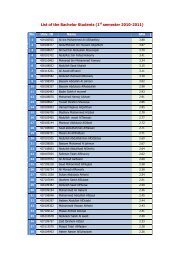
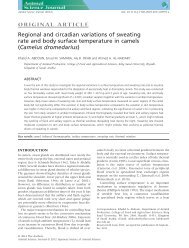
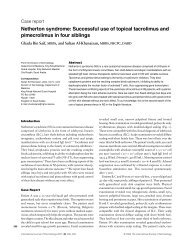
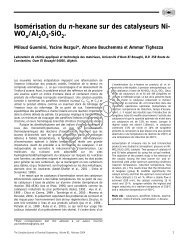
![التجربية الأولي [Read-Only] - KSU](https://img.yumpu.com/15502211/1/190x135/-read-only-ksu.jpg?quality=85)
